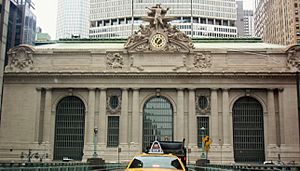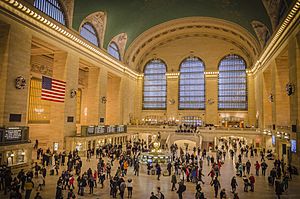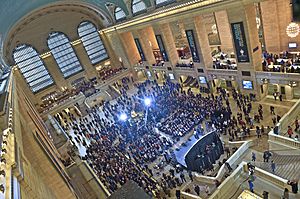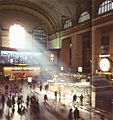Grand Central Terminal facts for kids
Grand Central Terminal (often called Grand Central Station) is a famous train station in New York City. You can find it at 42nd Street and Park Avenue in Midtown Manhattan. It's known for being the largest train station in the world. This is because it has the most platforms for trains.
Contents
What's in a Name?
Grand Central Terminal got its name from the New York Central Railroad. This company built the station and two older stations on the same spot. Many people often call it "Grand Central Station." This was the name of the station that was there before, from 1900 to 1910. The name "Grand Central Station" is also used for a nearby post office and a subway station.
A Look Back at History
The very first train station on this land was built in 1871. It was called "Grand Central Depot." The New York Central Railroad built it. Back then, many people traveled long distances by train.
In 1913, the station was rebuilt and got its current name, "Grand Central Terminal." Even though its official name changed, many people still call it "Grand Central Station" today.
Amazing Architecture
Grand Central Terminal was designed in a beautiful style called Beaux-Arts. Two main companies, Reed and Stem and Warren and Wetmore, worked on its design. French artists also helped create many detailed parts inside the station.
People in America really love Grand Central Terminal. In a survey, it was ranked as one of the most favorite buildings in the country. It was also named a Historic Civil Engineering Landmark in 2013. This shows how important and well-built it is.
The station is very large. It measures about 722 feet (220 meters) along Vanderbilt Avenue. It is also about 300 feet (91 meters) wide on 42nd Street. The building stands about 125 feet (38 meters) tall.
How the Station is Laid Out
Grand Central Terminal covers a huge area of 48 acres. It has 44 platforms on two different levels. These platforms have 67 tracks in total. There are 41 tracks on the upper level and 26 tracks on the lower level.
All these tracks are built underground. They are at the end of a long tunnel under Park Avenue. Trains here must switch from diesel to electric power. They use a special "third rail" to get electricity. This helps avoid exhaust fumes underground. These trains carry commuters to different parts of New York State and Connecticut.
Updates and New Additions
In 1995, Grand Central Terminal got a big makeover. The inside of the station was cleaned and fixed up. For example, the famous ceiling in the Main Concourse was cleaned. This revealed the beautiful painted sky and stars that were hidden by dirt. A new staircase was also added to match an existing one. The renovation finished in 1998.
In 2020, the MTA (Metropolitan Transportation Authority) bought the terminal. This means the public transportation agency now owns this important building.
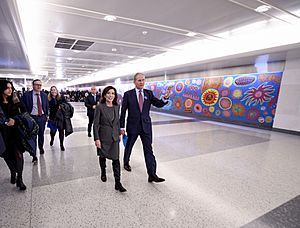
In 2013, the terminal celebrated its 100th birthday! Many events and performances were held. In 2020, a new skyscraper called One Vanderbilt opened next to the terminal. It has a special passage connecting it to Grand Central.
A big new addition opened in January 2023. It's called Grand Central Madison station. This new station is built right underneath Grand Central Terminal. It serves the Long Island Rail Road. This huge project cost $11.1 billion. LIRR trains now arrive on eight tracks across two levels, more than 90 feet (27 meters) below the Metro-North tracks. The new station also has a large area for shops and restaurants.
Images for kids
-
Baggage car mistakenly identified as Franklin D. Roosevelt's personal car, on display at the Danbury Railway Museum
-
The MetLife Building was completed in 1963 above part of Grand Central Terminal.
-
The Main Concourse in 1986, featuring the Kodak Colorama, the illuminated clock, and two banks
-
The Helmsley Building, in front of the MetLife Building, was built as part of Terminal City, a commercial and office district created above the tracks
-
Saturday Night Live stage replica at a Museum of Broadcast Communications exhibition, 2018
See also
 In Spanish: Grand Central Terminal para niños
In Spanish: Grand Central Terminal para niños


